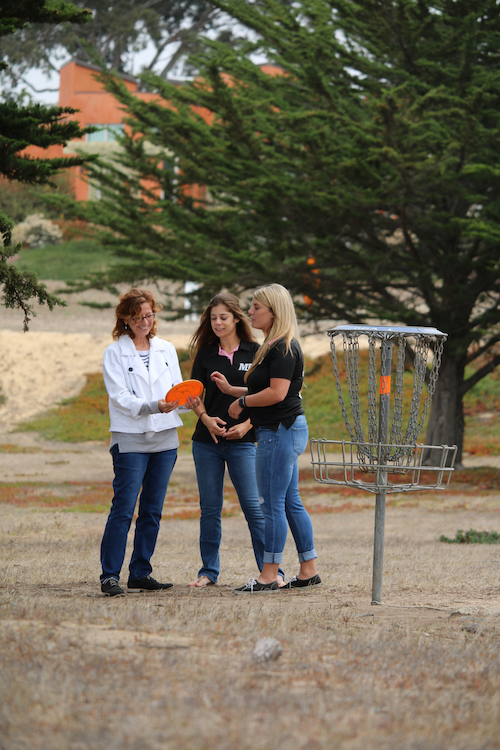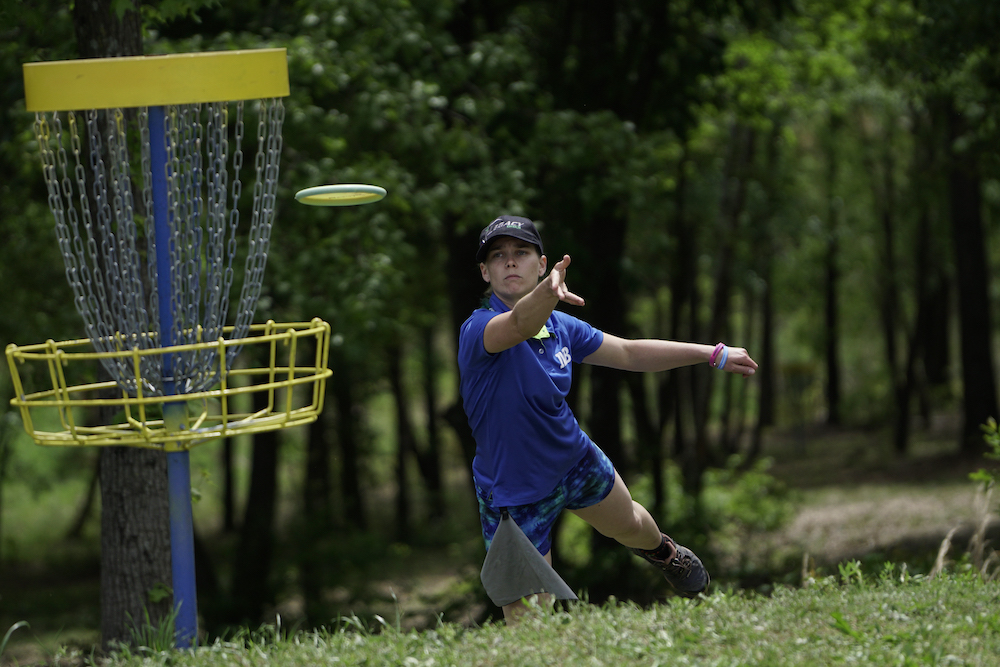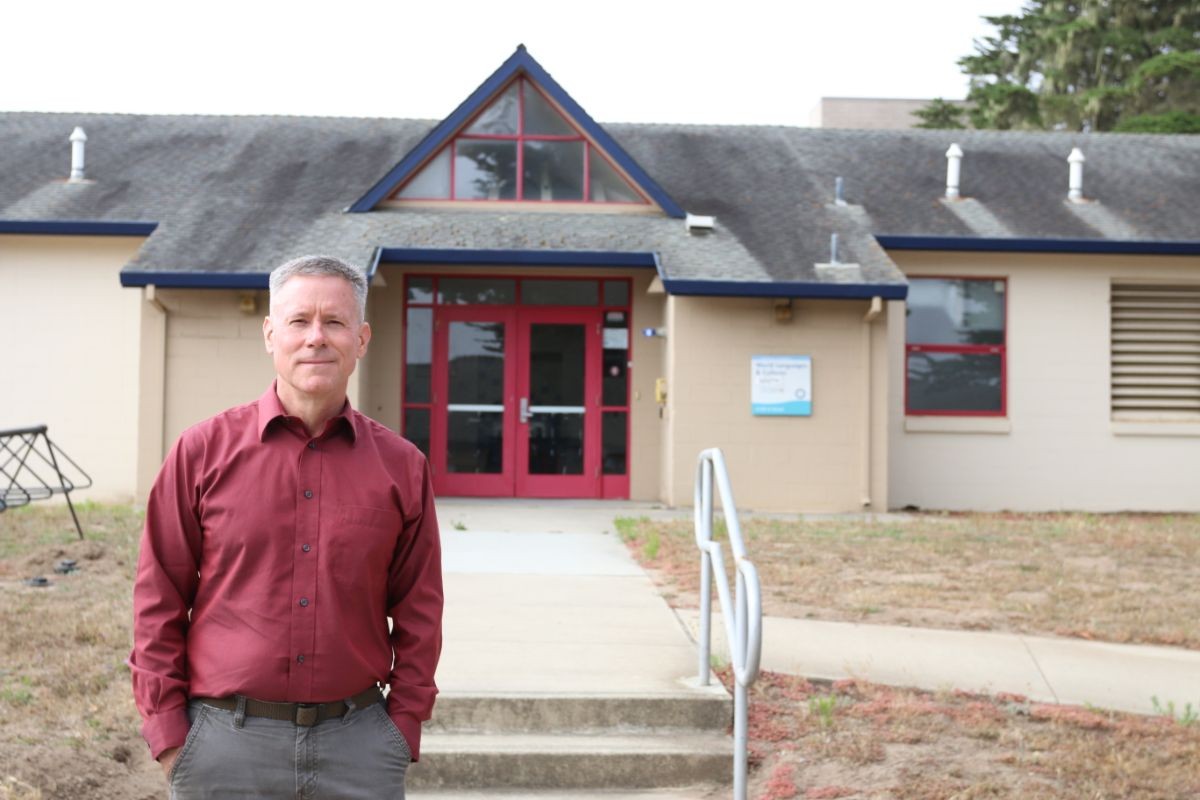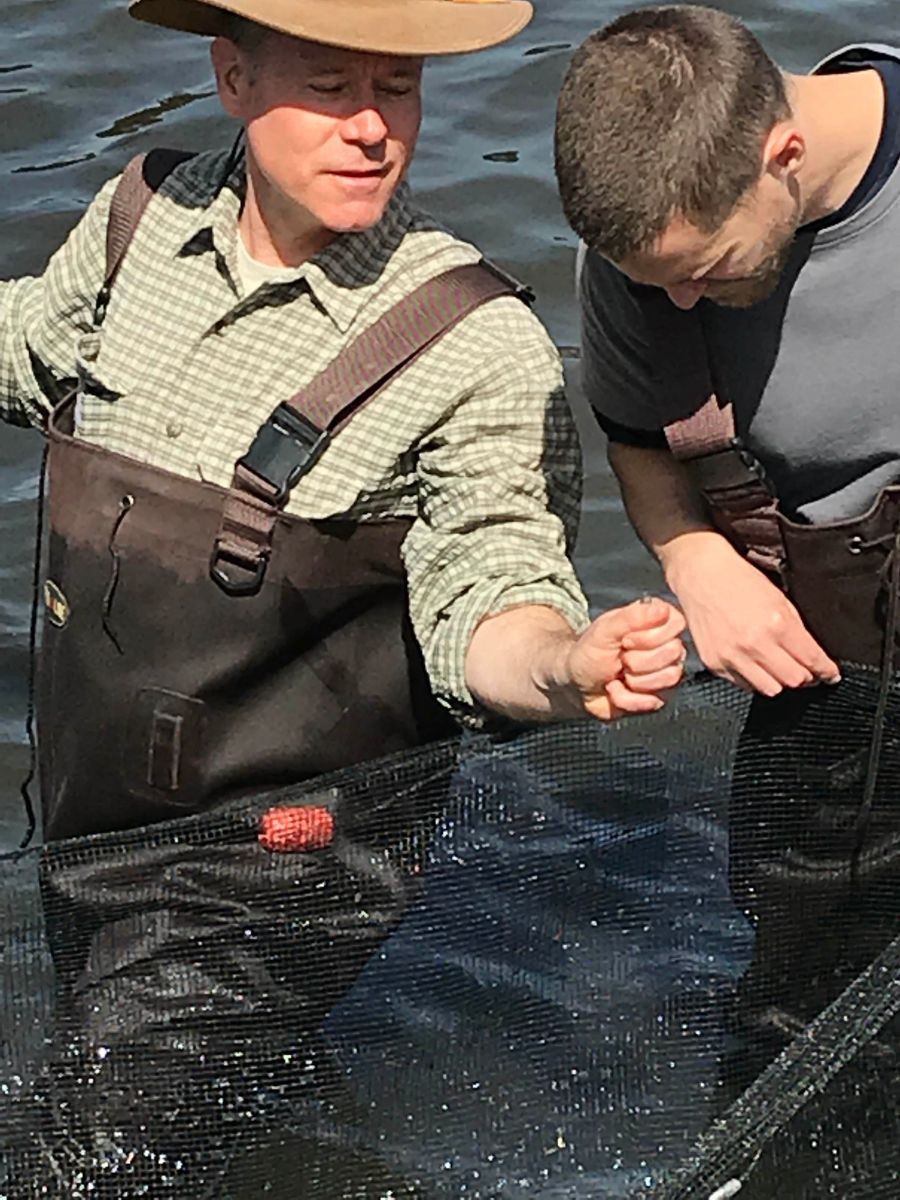CSUMB Magazine
Full Circle
CSUMB Women’s Disc Golf Bring Home National Championships

An unlikely powerhouse
There they are, smiling and holding the national championship trophy.
Traci Alger, Mikaela Bogdan, Bayli Miller and Jenn Schopfer just got done blitzing the field by 35 strokes for the women’s championship in the 2016 National Collegiate Disc Golf Championships held in North Augusta, South Carolina.
It’s a good story, sure. But what makes it even better is all those people not pictured, people like Mary Ann Ebner, Merle Witvoet, Scott Keasey, Steve Bonar, Greg Pool and, of course, “Steady” Ed Headrick, “The Father of Disc Golf.” They all played a part in making Cal State Monterey Bay an unlikely powerhouse in this growing sport.
Ebner was the recreation program coordinator for the Wellness Recreation and Sport Institute in the early days of the campus.
“Everyone had an idea, which was great. There was so much energy around opening up programs to serve students,” said Ebner.
A perfect fit
Among those with big ideas were Keasey and Bonar, students in the Institute for Management and International Entrepreneurship, who shared a love of disc golf.
They often drove to Delaveaga in Santa Cruz to play there.
“I think we started talking about it on one of those drives. What if we put a disc golf course on CSUMB’s campus?” Keasey said. Ebner liked the idea, and learned more about it from Witvoet, an early disc golf advocate.
“Merle had a lot of knowledge of the game to share with me. It didn’t take much to sell me on it, it was a perfect fit. It wasn’t going to disrupt the natural environment,” Ebner said.

“We were talking to Mary Ann about putting a course in,” said Witvoet, who teaches a class in disc golf and coaches the CSUMB men’s and women’s teams. “And then the two students came along – Keasey and Bonar – and said ‘we’re putting a course in, are you with us?’ I said sure.”
The right time
Pool, now the web services lead in technology support services, signed on as advisor to the program and helped it get established.
“We came in at the right time with an idea that would bring students out of the dorm and create more activity in the heart of campus,” Keasey said.
Disc golf – as opposed to its more famous cousin “ball golf” – does not require manicured fairways and greens. The courses often wind through natural areas, marked by pads where players “tee off” and baskets where the discs eventually end up.
As such, it was well-suited to many areas on and around the new campus. But money was short, and even the low- expense sport of disc golf is not a no-expense sport.
However, Bonar and Keasey discovered something interesting. Just up the road – in Watsonville, in fact – was Headrick, who designed the modern Frisbee, invented the basket used in disc golf and designed more than 200 courses.
“Ed was super-generous to us,” Keasey said. Headrick helped design the CSUMB Cypress Course, located along Inter-Garrison across from the University Police Department, and provided much of the material, to be paid back by revenues from disc sales.
Building a reputation
Over the years, CSUMB continued to build a reputation in the sport. The men’s team became a consistent contender in national tournaments. And, two years ago, the women’s team made the trip to the nationals as well.
Mikaela Bogdan was part of that team.
She had played a little disc golf in high school and liked it. “It is a good thing to do when you are hanging out with your friends, because it is a pretty relaxed sport. Nobody is yelling at you to be somewhere. So when I got here I saw there was a class, I said I guess I will try that.”
She ended up joining the women’s team.
“It took me a while to even decide to go to the nationals the first year,” she said. “I said I am terrible, why would I want to go? But it is a great experience, you get to see what it is like to be in the tournament. So I went (to the 2015 tournament), and it was a lot of fun, and our women’s team ended up winning. So that was cool.”

Cool, indeed. The CSUMB women won by one stroke over Oregon, and returned in the spring of 2016 to defend their title in emphatic fashion. Bogdan was CSUMB’s top individual finisher in 2016, taking 4th place.
Over the years, a second disc golf course has been built on campus – the Oaks course located off General Jim Moore Boulevard. And last year, a dozen volunteers, mostly from CSUMB, helped create a nine-hole disc golf course at Los Arboles Middle School in Marina.
Men’s and women’s disc golf are club sports at CSUMB, supported by the university’s Sports Club Council and fundraising efforts.
“It is great to see how far it has all come,” Keasey said. “CSUMB is a known entity in disc golf. People in the sport know teams come to compete. I have a ton of pride in them for what they have accomplished.”
A growing sport
Steady Ed passed away in 2002. At his request, his ashes were molded into a limited edition set of flying discs. His son Daniel told Sports Illustrated: “He said he wanted to end up in a Frisbee that accidentally lands on someone’s roof.”
So now, when you call the Disc Golf Association, which was founded by Headrick, and ask for the general manager, who do you get?
Scott Keasey, of course.
He worked in the Bay Area for a while after graduation, but was happy for the opportunity to come back south and work to promote this growing sport.
“It is low-impact, low-cost. The courses fit well into places you might not be able to do other things. Most of the courses are free; families can play together,” said Keasey, who said participation in the sport is growing every year.
Steady Ed would be proud.
Full Circle

By Noah Rappahahn
Published on Dec. 20, 2019
Assistant Professor John Olson first arrived at the soon-to-be California State University, Monterey Bay (CSUMB) campus in the summer of 1991 as a U.S. Army Captain, at a time when the “campus” had a much different purpose.
For much of the 20th century, Fort Ord military base served as a classroom for soldiers who attended class in the field and conducted “research” in foreign nations across the world. With shorter hair and equipped with the tools to fight and win our nation’s wars, the “pupils” of this era arose before dawn and spent their days and nights training in the dense foliage now known as Fort Ord National Monument.
Olson has had the unique privilege of leading both the young soldiers stationed at Fort Ord in the early 1990s and teaching CSUMB students in the Department of Applied Environmental Sciencein 2019. While the curriculum has changed significantly over the subsequent 25 years, the land that was once Fort Ord remains a place to learn for the eager young minds whose impact will have a global significance.
From 1991-93, Capt. Olson served in various roles with the U.S. Army’s 4th Battalion, 17th Infantry, 7th Infantry Division. He was battalion logistics officer when he learned that Fort Ord would be deactivated. The news came as a surprise to Olson, as he was already in the midst of supervising the units’ move to Fort Lewis in Tacoma, Washington.
As the battalion logistics officer, my mission changed from move everything, to turn everything in. I knew it was a very large operation to make everything disappear within six months’ time.”— Assistant Professor John Olson
“The original plan was for 7th Infantry Division not to go away, but to move to Fort Lewis. We were in the middle of packing up to move to Fort Lewis when I was informed that we were deactivating,” he said. “As the battalion logistics officer, my mission changed from move everything, to turn everything in. I knew it was a very large operation to make everything disappear within six months’ time.”
Preparing Fort Ord to be deactivated was a tedious and time-consuming operation, especially from a logistics standpoint, but there were some perks to being on such a short timeline. The Army’s Moral, Welfare and Recreation (MWR) program, for example, provides service-members and their families with recreational community activities to help contribute to their retention, readiness and emotional well-being. In this case, the MWR had a 12-month budget but only six months’ time.
“One of the most entertaining parts about closing down Fort Ord was the excess MWR fund. MWR used the funds to buy tee times at Pebble Beach and gave them away to the soldiers. A lot of young soldiers were able to play Pebble Beach who otherwise would have never had that opportunity. I’ll never forget that.”
It was not all fun and games for Olson, however, who was ultimately responsible for ensuring that every last piece of gear was submitted back into the Army’s logistics system for redistribution across the country. Once this mission was complete, it was Olson who physically locked the doors on the last buildings owned by the Army on Fort Ord; buildings that would eventually become CSUMB’s student services buildings.

Olson left the military shortly after Fort Ord’s closure in 1993 and changed careers, becoming a renowned freshwater scientist. He studies how rivers, lakes and streams are influenced by their watersheds.
His knowledge improved river health and management across the nation, first in the Southeastern United States while earning his master’s in Environmental Science from Columbus State University in 2002, and later in the Great Basin, Rocky Mountains and the Desert Southwest, while earning his doctorate from Utah State University in 2012. It wasn’t until 2015 that Olson considered returning to the place he once knew as Fort Ord.
“I never really thought specifically about returning to CSUMB, but I did know that it had been created and existed. We drove through here in the early 2000s just to see what was still here, and we were amazed to see that some of our old buildings were still standing. I acknowledged CSUMB as a possibility, but there were several reasons I thought that it would never actually happen.”
In December 2015, Olson was a researcher at the Desert Research Institute in Las Vegas. While visiting San Francisco for a conference, he was on a ferry when he noticed three different people had emailed him regarding a job posting at CSUMB.
“I was very happy at the Desert Research Institute and was planning on staying there for the rest of my life. But when I saw the job posting specific to freshwater ecology with large emphasis on spatial analysis I thought, ‘That’s sort of my thing, I should probably apply for this!’ ”
Olson landed the interview and received parking instructions from CSUMB’s Human Resources. The instructions directed him to a parking lot outside of building 58 – the same parking lot where he once parked as Capt. John Olson more than 20 years prior.
“When I arrived, I pulled into that same exact parking lot where I used to park 25 years before. It was just completely surreal. It was all the same, but all completely different at the same time.”
Olson officially returned to CSUMB for the spring semester of 2017, nearly 24 years after he locked the doors to Fort Ord in 1993. He has since mentored eight graduate students and 16 undergraduate students on various freshwater ecology research projects.
I am still doing a lot of the same basic things, just with a different purpose. I give a team a goal, and a challenge to achieve while helping them understand how what they are doing fits into the broader context. I get to explain how their actions will affect the greater good.”— Assistant Professor John Olson
One project in particular stands out. It is funded by the Department of Defense (DOD) and studies environmental DNA at several military installations on California’s Central Coast.
Olson and his student researchers have measured environmental DNA at over 100 sites across Vandenberg Airforce Base, Camp Hunter Liggett, Camp Roberts, Camp San Luis Obispo and Los Padres National Forest. The research results will be used to design better conservation strategies both for DOD and non-DOD lands.
“I had about 20 students out collecting data across all these locations. The students really had the full experience, driving remote roads, getting stuck, fording rivers and accessing beautiful and remote places that most people don’t ever get the chance to see,” Olson said.
“We can identify these places where the highest conservation value exists and better protect them. It is very valuable, applicable and important research that we are doing.”
Although his professional mission has changed significantly over 25 years, Olson has observed some similarities between the leadership values in his role as a military officer and as a faculty member at CSUMB.
“I was really surprised by how many of my military leadership skills transferred over to teaching. I was never really taught how to teach, but I would always hear other professors referring to a term called ‘scaffolding.’ I finally figured out that was the same concept we used in the military called ‘crawl, walk, run.’ It’s the same exact concept, so I found that those skills really translated well from military officer to faculty.”
“I am still doing a lot of the same basic things, just with a different purpose. I give a team a goal, and a challenge to achieve while helping them understand how what they are doing fits into the broader context. I get to explain how their actions will affect the greater good.”
Over the last 25 years, CSUMB has undergone its own scaffolding process and successfully transformed a former military base into a nationally-recognized, comprehensive university that prepares students to be innovative leaders and thriving citizens. Olson’s personal story seems to mirror it all, and take it even one step further.
“It’s really full circle for me. I was stationed here in the Army, and now I am here conducting research with CSUMB students; research that is being funded and used by the DOD. It’s just amazing how this has all come together.”